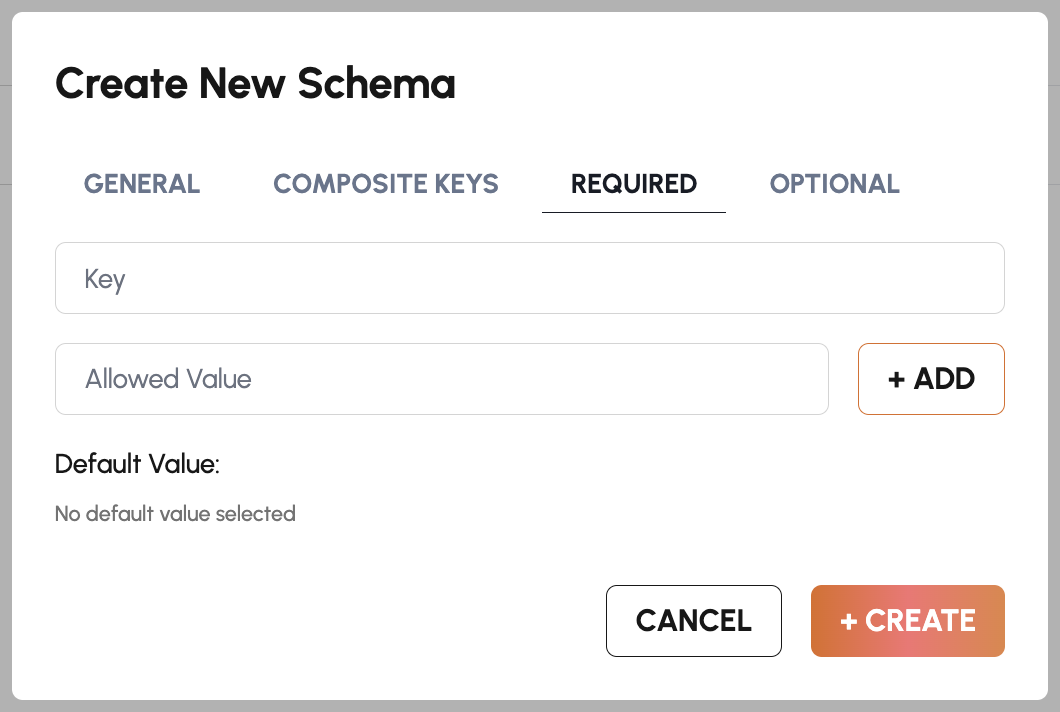One of the reasons why documents are known as unstructured data is because they do not have a fixed set of properties. While you may have a form that has specific fields to be filled in, you likely have multiple types of documents to manage, and even among one specific form, you may have a wide range of acceptable inputs allowed, even entire sections that are filled out in some cases and left blank in others.
And even in an organization with a well-oiled system of forms and other document templates, there will always be some documents that just don’t fit in with the others.
So a good, flexible document management system allowed for this lack of structure. But a good, flexible document management system also allows you to enforce structure where you need it.
With FormKiQ, we enable this flexibility and structure with Schemas.
Understanding Schemas in Document Management
At its core, a schema in document management defines the structure, content, and metadata of documents within a system. It's like a blueprint that dictates how documents should be organized, classified, and accessed.
By utilizing schemas, FormKiQ ensures that documents must adhere to a predefined format in order to be considered a valid document within the specified classification, making it easier to validate, store, and retrieve them efficiently.
The Primary Role of Schemas: Validation
Schemas allow specific workflows and actions to be triggered on valid documents, and can even create an alternative path for documents that are not valid, such as creating a NIGO (“not-in-good-order”) task to enable the document to be modified or otherwise handled.
Validation comes with a combination of required, default, and optional attributes that can be specified for a document class.
For example, an “invoice” class can be created that would require metadata such as invoice number, date of issue, buyer and seller information, the total amount due, and payment terms.
Optional attributes could include a purchase order number, taxes, and notes, while there could also be default attributes like currency.
When a document is assigned to that class, it would need to meet the validation criteria in order to be set as a valid document for that class. This validation is handled within FormKiQ, versus in an external client application, in order to ensure that all documents meet these requirements, no matter how they arrived in the system.
Schemas and Document Discovery
Schemas also enable more efficient document discovery. One of the most important advantages of a scalable document management system is that as more documents and metadata are added or more users are onboarded, the performance of the system is not negatively impacted by the increase in data or usage.
FormKiQ enables more efficient discovery with schemas, providing a way to set up the most common search paths with composite keys of metadata.
For example, an invoice that should be searchable by both invoice number and customer name can use a composite key, enabling a cost-effective and high-performance search to be performed without requiring additional infrastructure.
There are other ways to search for documents, of course, such as using fulltext search or more complex queries, but most high-usage discovery can be performed more effectively by using these schemas.
Conclusion
By using schemas to enforce validation and standardization, and to enable more efficient infrastructure usage, organizations can manage their documents and other information more effectively, ultimately leading to better decision-making and operational excellence.
Discover the potential of leveraging schemas for your organization. To learn more about FormKiQ, please
contact us or schedule a consultation call.
 FormKiQ vs. Off-the-Shelf Software and Less Flexible SaaS When is FormKiQ a better choice than Off-the-Shelf Software and Less Flexible SaaS?
FormKiQ vs. Off-the-Shelf Software and Less Flexible SaaS When is FormKiQ a better choice than Off-the-Shelf Software and Less Flexible SaaS? FormKiQ vs. Building It Yourself How does FormKiQ save time over custom in-house solutions?
FormKiQ vs. Building It Yourself How does FormKiQ save time over custom in-house solutions? Use Cases FormKiQ works for small and large workflows, across all verticals and industries.
Use Cases FormKiQ works for small and large workflows, across all verticals and industries. FormKiQ For Teams Find out how FormKiQ can work for your team
FormKiQ For Teams Find out how FormKiQ can work for your team FormKiQ For Industries Discover the advantages FormKiQ can bring to your industry
FormKiQ For Industries Discover the advantages FormKiQ can bring to your industry Blockchain and Decentralized Storage Leverage web3 technologies including proof of work and distributed systems for document control and data privacy
Blockchain and Decentralized Storage Leverage web3 technologies including proof of work and distributed systems for document control and data privacy Content and Digital Asset Management Integrate with your preferred web content management system while leveraging FormKiQ for managing your digital assets
Content and Digital Asset Management Integrate with your preferred web content management system while leveraging FormKiQ for managing your digital assets Document Management Module Integrate all of the required functionality of a document management system into an existing software solution
Document Management Module Integrate all of the required functionality of a document management system into an existing software solution Integration with QMS or LIMS Add missing functionality for your Quality Management or Laboratory Information Management by integrating with FormKiQ
Integration with QMS or LIMS Add missing functionality for your Quality Management or Laboratory Information Management by integrating with FormKiQ Job Application Form Receive applications, including cover letter and resume attachments, and import into an existing HR Management System
Job Application Form Receive applications, including cover letter and resume attachments, and import into an existing HR Management System Legal Discovery Tool Find information quickly by combining full-text search with AI-powered document classification
Legal Discovery Tool Find information quickly by combining full-text search with AI-powered document classification The Paperless Office: Digital Document Processing Collect, process, and store paper and digital documents, allowing for archival, integration, and future recall
The Paperless Office: Digital Document Processing Collect, process, and store paper and digital documents, allowing for archival, integration, and future recall Product Leasing System Process client lease applications, including a credit check and approval workflow
Product Leasing System Process client lease applications, including a credit check and approval workflow Company-Wide Break down the silos in your organization with a centralized control center for documents, ready for integration with any and all systems
Company-Wide Break down the silos in your organization with a centralized control center for documents, ready for integration with any and all systems Engineering and Product Reduce development time and agony with battle-tested components for your applications
Engineering and Product Reduce development time and agony with battle-tested components for your applications Finance and Accounting Process paper and electronic invoices and receipts, ready for integration with your important systems
Finance and Accounting Process paper and electronic invoices and receipts, ready for integration with your important systems HR and Recruiting Build and support your people across the organization by integrating with your essential tools
HR and Recruiting Build and support your people across the organization by integrating with your essential tools IT and InfoSec Provision a secure document store with the encryption and controls needed for compliance and protection
IT and InfoSec Provision a secure document store with the encryption and controls needed for compliance and protection Legal Manage and safeguard contracts and other essential documents across systems
Legal Manage and safeguard contracts and other essential documents across systems Marketing Add better discovery and reliability to digital assets and other essential content, while enabling integration with a web content management system
Marketing Add better discovery and reliability to digital assets and other essential content, while enabling integration with a web content management system Sales Keep track of sales assets and contracts inside and outside of your CRM and other tools
Sales Keep track of sales assets and contracts inside and outside of your CRM and other tools Accounting, Financial Services, and FinTech Standardize financial documents, metadata, and workflows across systems, teams, auditors, and clients
Accounting, Financial Services, and FinTech Standardize financial documents, metadata, and workflows across systems, teams, auditors, and clients Education, Training, and EdTech Integrate Learning Management Systems with other essential applications and tools
Education, Training, and EdTech Integrate Learning Management Systems with other essential applications and tools Healthcare, Life Sciences, and MedTech Combine secure and compliant records management with laboratory information management systems
Healthcare, Life Sciences, and MedTech Combine secure and compliant records management with laboratory information management systems Law Practices and Legal Services Ensure efficient legal discovery and case management
Law Practices and Legal Services Ensure efficient legal discovery and case management Logistics and Transportation Provide a robust and customized solution for fleet management or other logistics needs
Logistics and Transportation Provide a robust and customized solution for fleet management or other logistics needs Manufacturing, Production, and Utilities Control and distribute essential documents and standard operating procedures within and between facilities, partners, and clients
Manufacturing, Production, and Utilities Control and distribute essential documents and standard operating procedures within and between facilities, partners, and clients Online Entertainment, Gaming, and Gambling Provide the required compliance documents to partners, customers, and government agencies
Online Entertainment, Gaming, and Gambling Provide the required compliance documents to partners, customers, and government agencies Professional and Technical Services Ensure that clients, inspectors, and subcontractors are aligned with consistent document control
Professional and Technical Services Ensure that clients, inspectors, and subcontractors are aligned with consistent document control Tech Startups Build robust document management functionality into your disruptive product
Tech Startups Build robust document management functionality into your disruptive product








